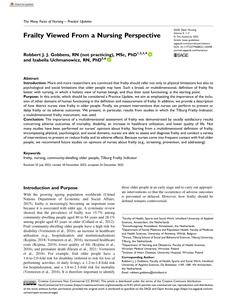Abstract Background An increasing number of the ageing population worldwide is at risk of becoming frail and incapacitated. This has the potential to impact not only on the well-being of individuals but also on the sustainability of healthcare systems. Objective The aim of this study was to explore the views and experiences of frailty from the perspective of primary care professionals, including nurses, who work directly with older people within the community. Methods A qualitative approach with a descriptive phenomenological methodology was used, which focused on exploration of primary care professionals' current experiences of early detection and prevention of the onset of frailty. Four multi-professional focus groups were held with a total of thirty-three primary care professionals who worked with older people as part of their daily role. Participants included district nurses, general practitioners, home care workers, physiotherapists and social workers. Results Professional views encompassed typical patterns of ageing, loneliness, presence of comorbidity, disability and end of life, with social conditions prevalent in most frailty they encountered. Three main themes emerged: the psychosocial nature of frailty, late detection of frailty and barriers to the feasibility of prevention. Physical frailty was considered a constituent part of ageing, which recognised the presence of a skills gap related to the detection of the early signs of frailty. Present health and social care systems are not designed to prevent frailty, and the competencies required by health and social care professionals are not usually included as part of their training curricula. This may hinder opportunities to intervene to prevent associated decline in ability of older adults. Conclusions To enhance the early assessment of frailty and the planning of preventive multi-factorial interventions in primary care and community settings, training and effective detection strategies should be incorporated into the role and daily care activities of primary care professionals. Implications for practice Using a multidimensional assessment instrument can help primary care professionals to identify older people who are frail or may become frail. In order to be able to carry out this properly strong inter-professional collaboration is needed. In addition, interventions aimed at preventing frailty or adverse outcomes of frailty should be tailor-made and thus should meet the needs and wishes of an older person.
LINK
Abstract: Nurses come into frequent contact with frail older people in all healthcare settings. However, few studies have specifically asked nurses about their views on frailty. The main aim of this study was to explore the opinions of nurses working with older people on the concept of frailty, regardless of the care setting. In addition, the associations between the background characteristics of nurses and their opinions about frailty were examined. In 2021, members of professional association of nurses and nursing assistants in the Netherlands (V&VN) received a digital questionnaire asking their opinions on frailty, and 251 individuals completed the questionnaire (response rate of 32.1%). The questionnaire contained seven topics: keywords of frailty, frailty domains, causes of frailty, consequences of frailty, reversing frailty, the prevention of frailty, and addressing frailty. Regarding frailty, nurses especially thought of physical deterioration and dementia. However, other domains of human functioning, such as the social and psychological domains, were often mentioned, pointing to a holistic approach to frailty. It also appears that nurses can identify many causes and consequences of frailty. They see opportunities to reverse frailty and an important role for themselves in this process.
DOCUMENT

Abstract Introduction: More and more researchers are convinced that frailty should refer not only to physical limitations but also to psychological and social limitations that older people may have. Such a broad, or multidimensional, definition of frailty fits better with nursing, in which a holistic view of human beings, and thus their total functioning, is the starting point. Purpose: In this article, which should be considered a Practice Update, we aim at emphasizing the importance of the inclusion of other domains of human functioning in the definition and measurement of frailty. In addition, we provide a description of how district nurses view frailty in older people. Finally, we present interventions that nurses can perform to prevent or delay frailty or its adverse outcomes. We present, in particular, results from studies in which the Tilburg Frailty Indicator, a multidimensional frailty instrument, was used. Conclusion: The importance of a multidimensional assessment of frailty was demonstrated by usually satisfactory results concerning adverse outcomes of mortality, disability, an increase in healthcare utilization, and lower quality of life. Not many studies have been performed on nurses’ opinions about frailty. Starting from a multidimensional definition of frailty, encompassing physical, psychological, and social domains, nurses are able to assess and diagnose frailty and conduct a variety of interventions to prevent or reduce frailty and its adverse effects. Because nurses come into frequent contact with frail older people, we recommend future studies on opinions of nurses about frailty (e.g., screening, prevention, and addressing).
DOCUMENT
